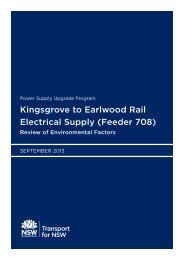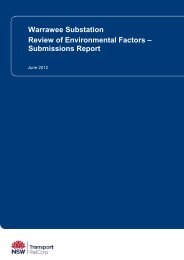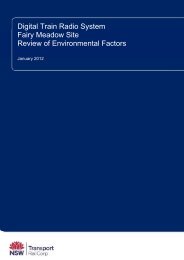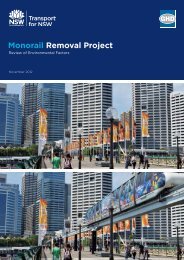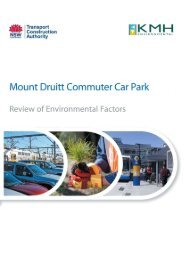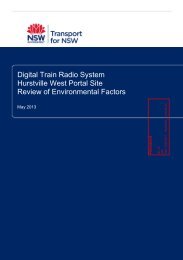Warrawee Substation - Review of Environmental Factors
Warrawee Substation - Review of Environmental Factors
Warrawee Substation - Review of Environmental Factors
- No tags were found...
You also want an ePaper? Increase the reach of your titles
YUMPU automatically turns print PDFs into web optimized ePapers that Google loves.
SpeciesControlcategoryLegal RequirementsNarrow-leaf Privet (Ligustrum sinense) 4 manner that reduces its numbers spread andincidence and continuously inhibits itsflowering and reproductionRhizatomous Bamboo (Phyllostachys sp.) 4 The growth <strong>of</strong> the plant must be managed in amanner that continuously inhibits its vegetativereproduction and the plant must not be soldpropagated or knowingly distributedCape Broom (Genista monspessulana) 3 The plant must be fully and continuouslysuppressed and destroyedFaunaThirteen bird species, three reptile species and two frog species were recorded opportunistically duringthe site visit, including two exotic bird species (see Appendix A). No threatened fauna species wereobserved: only common, generalist species typical <strong>of</strong> highly disturbed urban areas were recorded.Habitats at the site would have limited value for native fauna, given the degree <strong>of</strong> disturbance observedand lack <strong>of</strong> native vegetation.The aggressive Noisy Miner (Manorina melanocephala) was the most frequently observed andapparently dominant bird species at the site. Other species observed were typically large birds commonin urban gardens, such as the Sulphur-crested Cockatoo (Cacatua galerita), Rainbow Lorikeet(Trichoglossus haematodus), and Red Wattlebird (Anthochaera carunculata). Dense stands <strong>of</strong> exoticvegetation would have potential value as shelter habitat for small birds, but these stands are small andfragmented and would have limited value for most bird species given the observed presence <strong>of</strong>aggressive species such as the Noisy Miner.Flooded areas <strong>of</strong> the site would support small numbers <strong>of</strong> common frog species such as the CommonEastern Froglet (Crinia signifera) and Striped Marsh Frog (Limnodynastes peronii), which were recordedduring the site visit. Eastern Water Skinks (Eulamprus quoyii) were also observed basking near theculvert outlets. The drainage line to the south <strong>of</strong> the site and flooded grassy areas would provide habitatfor these common, generalist frogs and reptiles and other such species able to persist in urbanenvironments. There is no habitat for any threatened frogs or aquatic fauna at the site.1.1.1 Conservation significanceIn summary, the site comprises highly disturbed vegetation with few habitat resources for native fauna,and is therefore considered to have low conservation significance. There is no vegetation at the sitewhich would correspond to any threatened ecological community, and it is considered highly unlikely thatany threatened flora species would occur. Four threatened fauna species and two migratory birds mayoccur at the site on an occasional or opportunistic basis, but would be highly unlikely to be dependent onhabitats at the site for their conservation in the locality.21/19721/1780114



